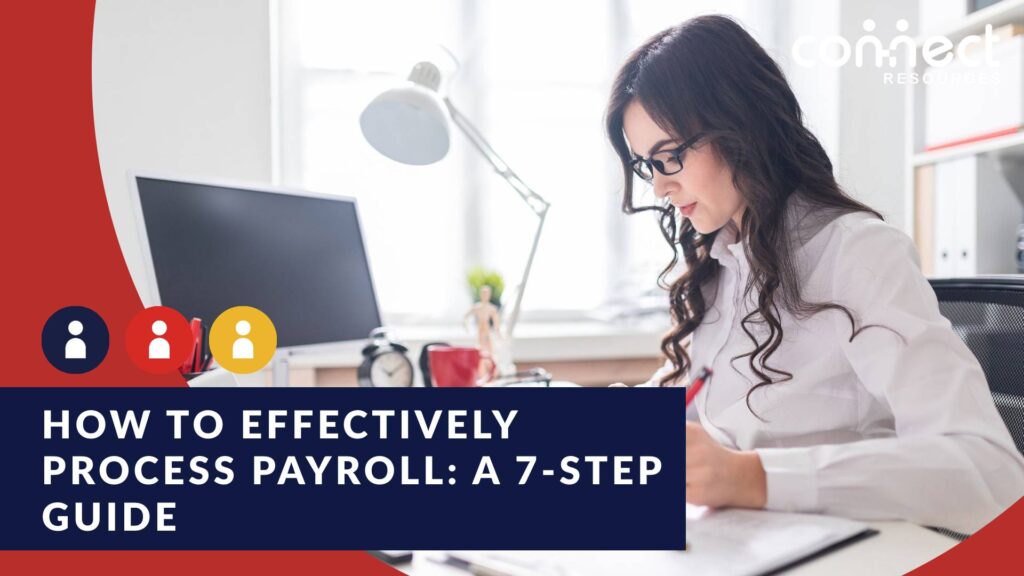The payroll process of a company is one of the most vital functions that must always be carried out efficiently. But in order to process payroll, it will be necessary to follow a number of specific steps to ensure accuracy. This way, you will be able to understand the payroll process and create a simplified workflow for your business too.
In this article, you will learn everything about the payroll process and the steps you must follow to complete it. More precisely, we will explain seven steps that all business owners should follow in order to process payroll correctly and efficiently. And with this guide that we will provide, your company will get lots of benefits, such as saving time considerably.
- What is the payroll function and why is it important?
- Steps to process payroll efectively
- Should you outsource your payroll functions to improve efficiency?
- How can Connect Resources help you make your payroll process more accurate?
1. What is the payroll function and why is it important?
Having a company and employees requires you to implement an effective and reliable payroll process to process all necessary payments. Payroll involves several elements that you must cover, such as calculation of payments, deductions, tracking employees’ work hours, taxes, etc. And payroll in HR is an essential function that you must carry out by following steps and using modern tools.
On the other hand, when we talk about the payroll process steps, you must be aware of every detail they include. Therefore, having a payroll process flowchart will help you a lot to understand how to process payroll efficiently and flawlessly. And below, you will be able to find more information about the procedures to complete each step of the operation.
1.1. What are the steps?
As we mentioned before, it is essential to complete a step-by-step payroll process in order to complete this vital task. More precisely, there are seven steps that you must carefully follow to process payroll successfully, which are the following:
- Firstly, gather all tax information from your employees.
- Then, create an employee record management process.
- Determine the pay schedules that you will use to pay your employees.
- After that, track time and attendance in order to calculate and process payroll.
- Then, calculate all respective deductions based on the deductions categories.
- When all previous payroll process steps are completed, start running your payroll.
- And lastly, you will need to submit all payroll tax payments and filing.
But before you start running this payroll process workflow, you need to understand how to complete each step. And below, you can discover how to complete each of these steps effectively and without wasting making mistakes. This guide will work as a useful payroll process workflow sample that will help you throughout the process.
2. Steps to process payroll effectively
2.1 First step: Gather tax information from your employees
The best way to start the UAE payroll process is by collecting the required tax information from each of your employees. And in order to verify employee eligibility, it is necessary that the employers complete and file the respective forms. Besides, it is necessary that the employees present the required identification documents to their employers before they start a new role.
On the other hand, you should know that there are several types of forms that employers must complete and file. Similarly, it is mandatory to complete any state-required withholdings forms in order to process payroll tasks. The importance of these forms relies on the fact that they help you provide the authorities with tax withholding information.
However, this is one of those payroll process steps that vary according to the situation. For example, in case you have independent contractors working for you, they are the ones who must complete these forms.
2.2 Second step: Create an employee record management process
The payroll process in HR requires a record management process, which must document any selections for benefits and retirement needs. And with the information that these records provide, you can accurately calculate payroll deductions during the process.
Furthermore, keeping an employee record that includes employment contracts, employee handbooks, tax forms, and training requires other things. For example, these documents must be signed and stored for compliance purposes.
Moreover, you should use a strategy to handle your employee record management and process payroll easily. And some of the best types of employee record-keeping methods that you can use are the following:
- Paper files: this method consists of storing physical employee documents and locking them away in a secure storage area. Although many companies still use this method, it is slowly turning into an obsolete option due to technological advances.
- Cloud-based document storage: most employers are opting for maintaining cloud-based documents instead of paper files. This method allows you to access documents anytime and anywhere, you will only need internet access. Besides, this option is far more secure and reduces compliance and security risks.
- Onsite servers: another option that you can use is having a private, computer-backed system to store data. And just like the previous option, it will allow you to get rid of physical paperwork and storage space. Nonetheless, you will still need computer hardware space and secure storage facilities as well.
2.3 Third step: Determine the pay frequency or pay schedules
Once you have completed the previous steps of the payroll management process, you will now need to determine this element. The pay frequency that you can offer to your employees can vary. In fact, there are four main pay schedules that you can use to pay your employees, which are the following:
- Weekly: in this case, the total number of pay periods will be 52. And it can run payroll, for example, every Thursday.
- Biweekly: this is another pay schedule that involves 26 pay periods. A calendar example, in this case, could be every 2nd and 4th Thursday.
- Semi-monthly: you can also opt for paying your employees on the 15th and 31st of every month. This payment frequency has a total number of pay periods of 24.
- Monthly: lastly, you can also pay your employees on a monthly basis, which means that there will be 12 pay periods.
2.4 Fourth step: Track time and attendance when calculating payroll
Tracking time and attendance will be a vital factor during the payroll process as well. In fact, the hours that your employees worked will determine most part of their employee pay. And the best to track time and attendance is by streamlining this process, so you can ensure that all worked hours are paid accurately.
Furthermore, keep in mind to track other time-related elements, such as breaks, lunches, accruals, and many others. Otherwise, it will be more difficult to accurately calculate the amount of money that your employees will receive, and they could be underpaid or overpaid. Therefore, make sure to implement the most effective time capture tools for your employees to use, such as:
- Cards.
- Timesheets.
- Mobile apps.
2.5 Fifth step: Calculate the respective deductions and their categories
The next step to process payroll is calculating all necessary deductions. And you should be aware of the different types of deductions that you must take into account, including the following:
- Pre-tax deductions: these must be taken out of your employees’ paychecks before withholding taxes. For example, they could be employer-sponsored health insurance, employer and employee retirement contributions, etc.
- Tax deductions: in this case, you must calculate the necessary taxes that you will withhold from your employees’ paychecks. Then, you must send that amount to the pertinent government entities.
- Post-tax deductions: lastly, make sure to take out these deductions from your employees’ paychecks after withholding taxes. For example, they could be employee insurance premiums, garnishments, and many others. For more information, make sure to contact a local payroll specialist.
2.6 Sixth step: Run payroll and pay your employees
After calculating all elements that the payroll process steps in the UAE involve, it is time to run your payroll. You must consider the payment methods that you will use to ensure your employees get paid accurately and promptly. For example, you can opt for using direct deposit, printed checks, or pay cards, depending on your employees’ requirements.
Furthermore, you must include holidays in the payroll process workflow, depending on the pay frequency. You must also remember that there can be delays or another impact on your payroll process schedule due to holidays. Therefore, planning is essential in order to pay your employees on time regardless of the situation.
2.7 Seventh step: Submit payroll tax payments and filing to the authorities
And the last step of this step-by-step payroll process guide is sending payroll taxes withheld to the pertinent government entities. However, this step will require you to submit specific documents to the authorities. And in this case, it is recommendable to get more information about this step from a payroll specialist.
3. Should you outsource your payroll functions to improve efficiency?
Although you can easily follow this simple step-by-step payroll process flowchart, there is another way to successfully process payroll. As a matter of fact, outsourcing all payroll functions can be even more favorable for many companies in the United Arab Emirates. And payroll outsourcing services will provide you with several benefits that will help your company grow and be more productive.
For example, these are some of the many advantages that companies can get by outsourcing payroll to a third party:
- Delegating payroll responsibilities allows company owners to save time and focus on their core activities.
- Companies can reduce costs and unnecessary expenses by letting a specialized agency, like Connect Resources, process payroll.
- Since payroll professionals will carry out this function, there will be fewer errors when processing payments.
- Working with a payroll outsourcing company allows companies to stay compliant with the labour laws and tax regulations.
- There will also be more security for your company’s payroll data and confidential information.
4. How can Connect Resources help you make your payroll process more accurate?
Since the payroll process in the UAE can be a bit complicated for most companies, outsourcing can be the best option. And with Connect Resources as your service provider, your business will get the most efficient payroll outsourcing services in Dubai. This way, carrying out your company’s payroll functions will no longer be a time-consuming task for you and your employees.
Besides your payroll management process, you can opt for outsourcing other functions, such as your HR department’s tasks and operations. And in this case, getting HR outsourcing services is key to improving the performance and efficiency of your department’s processes.
Furthermore, we can also provide you with HR consultancy services and useful guidance to help you manage your tasks effectively.
Would you like to learn more about the process to run your company’s payroll successfully? With Connect Resources, you will be able to get all the information you need about a successful and efficient payroll process. In addition, our specialists will provide you with the best outsourcing services, and you can get information about them by calling us at +971 43 316 688. Or you can opt for sending an email at contact@connectresources.ae to receive more details about our services. Contact us!
On the other hand, professionals like you who desire to get the best job opportunities should visit thetalentpoint.com. This is the best platform to look for job offers in Dubai and across the UAE without wasting too much time or effort. Besides, you can submit your CV and application by sending an email at contact@thetalentpoint.com, and the most experienced recruiters will help you find a job that suits your skills and requirements.











